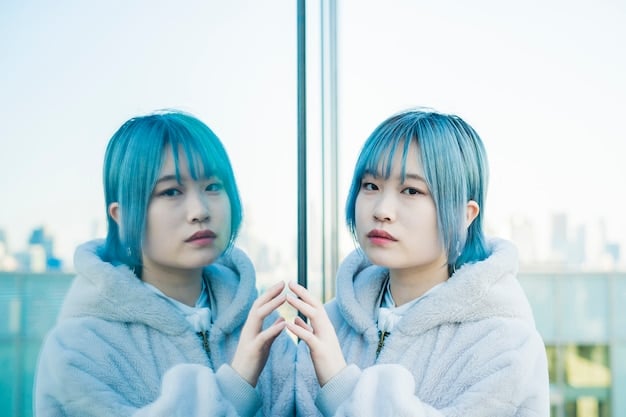Korean Drama Dubbing Controversy: Are US Viewers Rejecting English Dubs?

The Korean drama dubbing controversy revolves around the increasing debate among US viewers regarding the preference for subtitles over English dubs, impacting the authenticity and reception of K-dramas.
The Korean drama dubbing controversy: Are US viewers rejecting English dubs? is a hot topic among K-drama enthusiasts. While dubbing aims to make these shows more accessible, it often sparks debate about whether it enhances or detracts from the original viewing experience. Let’s delve into what US viewers really think.
The Rise of Korean Dramas in the US
Korean dramas, or K-dramas, have surged in popularity across the United States, captivating audiences with their compelling storylines, high production values, and charismatic actors. This surge is largely attributed to the widespread availability of streaming platforms that offer a diverse catalog of K-dramas, making them easily accessible to viewers nationwide. But accessibility has brought a debate to the forefront.
As more Americans discover the charm of K-dramas, how they choose to experience these shows—whether through dubbed versions or with subtitles—has become a point of contention. This preference significantly impacts how the original artistic intent is perceived, leading to discussions about authenticity and cultural appreciation.
Streaming Platforms and Accessibility
Streaming platforms play a pivotal role in popularizing K-dramas in the US. Netflix, Viki, and Crunchyroll offer extensive libraries of K-dramas, making it easier for viewers to discover and binge-watch their favorite shows. The accessibility provided by these platforms is a key factor in the rising popularity of K-dramas.
- Netflix: Features a wide array of popular K-dramas with both subtitle and dubbing options, appealing to a broad audience.
- Viki: Specializes in Asian dramas, including Korean dramas, with a strong focus on community-contributed subtitles, which often provide richer cultural context.
- Crunchyroll: Primarily known for anime, Crunchyroll also offers a selection of K-dramas, further expanding the reach of Korean content.
These platforms have invested heavily in acquiring and producing K-dramas, as they recognize the genre’s potential to attract and retain subscribers. For instance, Netflix’s original K-dramas, such as “Squid Game” and “Kingdom,” have achieved global success, highlighting the platform’s impact on the genre’s visibility.
In conclusion, the rise of Korean dramas in the US is deeply intertwined with the accessibility and variety offered by streaming platforms. These platforms not only make it easier for viewers to discover K-dramas but also contribute to the ongoing debate about the best way to experience them, particularly regarding dubbing versus subtitles.
Understanding the Dubbing Debate
The dubbing debate in the context of Korean dramas centers on whether English dubs enhance or detract from the original viewing experience for US audiences. While dubbing aims to make K-dramas more accessible, it often involves compromises that can alter the tone, nuance, and cultural context of the original content. Many viewers argue that subtitles provide a more authentic and accurate representation of the K-drama.
This debate isn’t just about personal preference; it touches on broader issues of cultural preservation and artistic integrity. Understanding the nuances of this debate requires examining the pros and cons of both dubbing and subtitles, as well as the specific concerns raised by viewers and critics.

Pros and Cons of Dubbing
Dubbing offers several potential advantages, particularly for viewers who may find it challenging to keep up with subtitles or who prefer to multitask while watching. However, it also comes with significant drawbacks that can impact the viewing experience.
- Pros:
- Accessibility: Dubbing makes K-dramas more accessible to a wider audience, including those who have difficulty reading subtitles.
- Multitasking: Viewers can watch without having to focus intently on reading, allowing them to engage in other activities simultaneously.
- Ease of Understanding: Dubbing can simplify complex cultural references and linguistic nuances, making the content easier to grasp.
- Cons:
- Loss of Authenticity: Dubbing often fails to capture the original voice acting’s emotional nuances, leading to a less authentic experience.
- Synchronization Issues: The lip-syncing can be off, which can be distracting and reduce immersion.
- Altered Dialogue: To fit lip movements, dialogue may be altered, sometimes changing the original meaning or intent.
Ultimately, understanding the dubbing debate involves weighing these pros and cons to determine whether the convenience of dubbing outweighs the potential loss of the original artistic integrity and cultural nuances of the K-drama.
In summation, the discussion surrounding dubbed versus subtitled K-dramas extends beyond mere convenience. It raises important questions about how best to experience and appreciate foreign content, balancing accessibility with cultural authenticity.
US Viewers’ Preferences and Opinions
US viewers exhibit diverse preferences when it comes to watching Korean dramas, with some strongly favoring subtitles and others preferring dubbing. These preferences are influenced by factors such as viewing habits, language proficiency, and personal beliefs about the authenticity of the viewing experience. Understanding these diverse opinions is crucial for content creators and distributors looking to cater to the growing K-drama audience in the US.
The debate over dubbed versus subbed versions of K-dramas is often heated, with viewers voicing their opinions on social media, online forums, and discussion boards. These platforms provide a space for fans to share their experiences and preferences, contributing to a broader understanding of the different viewpoints.
Surveys and Studies on Viewer Preferences
Various surveys and studies have been conducted to gauge US viewers’ preferences regarding K-drama viewing habits. These studies often reveal a split between those who prefer subtitles for their authenticity and those who opt for dubbing for its convenience.
- Subtitle Preferences:
- Many viewers feel that subtitles provide a more accurate representation of the original dialogue and cultural context.
- Subtitles allow viewers to appreciate the nuances of the Korean language, including honorifics and idiomatic expressions.
- Some viewers see watching with subtitles as a way to learn more about Korean culture and language.
- Dubbing Preferences:
- Dubbing is often preferred by viewers who find it difficult to read subtitles quickly or who prefer to multitask while watching.
- Some viewers feel that dubbing makes K-dramas more accessible and easier to understand, especially for those unfamiliar with Korean culture.
- Dubbing can be particularly appealing to younger audiences or viewers with visual impairments.
These studies also highlight the trade-offs viewers are willing to make. While subtitle enthusiasts may acknowledge the difficulty in keeping up with rapid dialogue, they often believe the trade-off is worth it for the authenticity and cultural immersion.
In summary, US viewers’ preferences regarding dubbed versus subbed K-dramas are diverse and influenced by a range of factors from viewing habits to cultural sensitivities. Understanding these preferences is essential for content creators and distributors aiming to cater to the growing K-drama audience in the US.
The Impact of Dubbing on Cultural Authenticity
The impact of dubbing on cultural authenticity in Korean dramas is a central concern in the dubbing debate. Many viewers argue that dubbing often diminishes or distorts the cultural nuances, emotional depth, and linguistic intricacies that make K-dramas unique. This can lead to a viewing experience that feels less authentic and less connected to the original artistic intent.
Cultural authenticity in K-dramas extends beyond mere dialogue; it encompasses body language, social customs, and subtle cues that are deeply embedded in Korean culture. Dubbing, in its attempt to make the content more accessible, can inadvertently strip away these elements, altering the viewing experience.

Loss of Linguistic Nuances
Korean language features distinct honorifics, idiomatic expressions, and social cues that are deeply ingrained in the culture. These linguistic nuances often convey subtleties about relationships, social status, and emotional states. Dubbing frequently struggles to capture these nuances effectively.
For example, consider the use of honorifics in Korean, which vary depending on the relationship between speakers. Dubbing may simplify these to generic terms, losing the original dialogue’s significance. Similarly, idioms and cultural references can be challenging to translate and adapt without losing their context and meaning.
- Honorifics: Dubbing often replaces specific honorifics with generic terms, diluting the original dialogue’s nuance.
- Idiomatic Expressions: Direct translations of Korean idioms can sound awkward or nonsensical in English, leading to altered or simplified versions.
- Cultural References: Dubbing may omit or explain cultural references that are easily understood by Korean viewers but unfamiliar to US audiences, disrupting the viewing experience.
In short, the impact of dubbing on cultural authenticity in Korean dramas is a multifaceted issue that touches on linguistic nuances, emotional depth, and artistic integrity. While dubbing may enhance accessibility, it often comes at the cost of diluting the unique cultural elements that make K-dramas special.
The Role of Subtitles in Preserving Original Intent
Subtitles play a crucial role in preserving the original intent of Korean dramas, offering US viewers a direct connection to the artistic vision and cultural nuances embedded within the shows. By providing a literal translation of the dialogue, subtitles allow viewers to appreciate the Korean language and culture in a more authentic way. This is particularly important for those who value cultural accuracy and artistic integrity in their viewing experience.
Unlike dubbing, which involves re-recording the dialogue in another language, subtitles offer a transparent representation of the original content. This transparency allows viewers to make their own interpretations and connections, enhancing their appreciation of the K-drama.
Accuracy and Cultural Context
Subtitles often provide additional context and explanations that help viewers understand cultural references, idiomatic expressions, and social cues. This is particularly valuable for those unfamiliar with Korean culture, as it enhances their understanding and appreciation of the K-drama.
- Direct Translation: Subtitles offer a direct translation of the dialogue, allowing viewers to hear the original voice acting and intonation.
- Cultural Notes: Many subtitle providers include cultural notes or explanations to help viewers understand references and customs.
- Language Learning: Watching with subtitles can be a useful tool for those interested in learning the Korean language, as it exposes them to vocabulary and grammar in a natural context.
Ultimately, the role of subtitles in preserving the original intent of Korean dramas is crucial for maintaining cultural accuracy and artistic integrity. By providing a direct and transparent translation of the dialogue, subtitles allow viewers to experience K-dramas in a way that respects and celebrates the unique aspects of Korean culture.
In summary, US viewers’ preference regarding the format in which they consume Korean dramas significantly shapes their viewing experience and cultural awareness. Authenticity is often prioritized among K-drama enthusiasts.
Future Trends in K-Drama Localization
Future trends in K-drama localization are likely to focus on striking a better balance between accessibility and cultural authenticity. As the K-drama audience in the US continues to grow, there is a greater demand for subtitling and dubbing solutions that respect the original artistic intent while catering to diverse viewing preferences. This could involve the development of improved dubbing techniques, enhanced subtitling options, and the incorporation of cultural notes to provide additional context.
The increasing sophistication of AI-driven translation tools may also play a role in future localization efforts, potentially leading to more accurate and nuanced subtitles and dubs. Additionally, there may be a greater emphasis on involving Korean cultural experts in the localization process to ensure that the cultural elements of K-dramas are accurately represented.
Technological Advancements in Translation
Technological advancements are already transforming the field of translation, with AI-driven tools becoming increasingly adept at capturing linguistic nuances and cultural context. In the future, these tools may be used to generate subtitles and dubs that are more accurate, natural-sounding, and culturally sensitive.
- AI-Powered Translation: AI-driven translation tools can analyze dialogue, identify cultural references, and suggest appropriate translations.
- Voice Synthesis: Advanced voice synthesis technology can create dubbed voices that closely resemble the original actors’ voices, preserving the emotional depth of the performances.
- Real-Time Subtitling: Real-time subtitling technology can generate subtitles on the fly, allowing for the creation of live, translated content.
These trends suggest a future where K-drama localization becomes more sophisticated, nuanced, and respectful of the original artistic intent. By embracing technological advancements and prioritizing cultural authenticity, the industry can cater to the growing demand for high-quality localized content while preserving the unique charm of Korean dramas.
In conclusion, the evolution of K-drama localization is poised to enhance both accessibility and cultural fidelity, ensuring viewers can fully appreciate the allure and artistry of Korean dramas.
| Key Point | Brief Description |
|---|---|
| 🎬 Dubbing Debate | Discusses accessibility versus loss of authenticity with English dubs. |
| 🌐 US Preferences | Highlights split preferences among US viewers for subtitles or dubbing. |
| 🔑 Cultural Impact | Addresses the impact of dubbing on preserving cultural nuances. |
| 🔮 Future Trends | Explores advances in translation for better localization. |
FAQ
▼
The debate stems from concerns that dubbing may alter the cultural nuances and emotional tones inherent in the original Korean performances, potentially diminishing the viewing experience.
▼
Preferences vary widely. Some appreciate dubs for accessibility, while others prefer subtitles for a more authentic experience of the language and acting.
▼
Dubbing can sometimes simplify or omit cultural references, idiomatic expressions, and honorifics, which are integral to understanding Korean social dynamics.
▼
Subtitles allow viewers to experience the original language, acting, and audio elements while providing a direct translation, maintaining the show’s integrity.
▼
Future trends include AI-enhanced translations for more nuanced results and cultural experts’ involvement for authenticity, optimizing both accessibility and original appeal.
Conclusion
Ultimately, the Korean drama dubbing controversy: Are US viewers rejecting English dubs? highlights a multifaceted debate with passionate opinions on both sides. While dubbing enhances accessibility, many viewers champion subtitles for their cultural authenticity. As technology evolves, future localization efforts may bridge this divide, balancing accessibility with respect for the original artistic vision of K-dramas.





